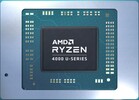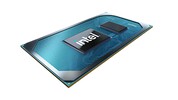AMD Ryzen 7 4800U vs Intel Core i5-1155G7 vs AMD Ryzen 5 4600U
AMD Ryzen 7 4800U
► remove from comparison
The AMD Ryzen 7 4800U is a processor for thin and light laptops based on the Renoir architecture. The 4800U integrates all eight cores based on the Zen 2 microarchitecture. They are clocked at 1.8 (guaranteed base clock) to 4.2 GHz (Turbo) and support SMT / Hyperthreading (16 threads). The chip is manufactured in the modern 7 nm process at TSMC and partly thanks to it AMD advertises a 2x improved performance per Watt for the Renoir chips. Compared to the similar named Ryzen 7 4800H, the 4800U offers a lower TDP (15 versus 45 Watt) and base clock (1.8 versus 2.9 GHz).
According to AMD, the Ryzen 7 4800U is 4% faster in Cinebench R20 single thread test and 90 % faster in the multithreaded test compared to the fast Intel Core i7-1065G7 (Ice Lake, 4 cores, 3.9 GHz). This means the CPU should be one of the fastest processors in the 15 Watt TDP range and well suited for demanding tasks. The sustained performance however ist strongly depending on the cooling system and the TDP settings of the laptop.
In addition to the eight CPU cores, the APU also integrates a Radeon RX Vega 8 integrated graphics card with 8 CUs and up to 1750 MHz. The dual channel memory controller supports DDR4-3200 and energy efficient LPDDR4-4266 RAM. Furthermore, 8 MB level 3 cache can be found on the chip. See our hub page on the Renoir Processors for more information.
The TDP of the APU is specified at 15 Watt (default) and can be configured from 10 to 25 Watt by the laptop vendor. That means the chip is intended for thin and light laptops (but with fans).
Intel Core i5-1155G7
► remove from comparison
The Intel Core i5-1155G7 is a power efficient quad-core SoC for laptops and Ultrabooks based on the Tiger Lake-U generation that was announced in mid 2021 as part of the refresh. It integrates four Willow Cove processor cores (8 threads thanks to HyperThreading). The base clock speed depends on the TDP settings and ranges from 1 GHz (12 Watt TDP) up to 2.5 GHz (28 Watt). Boost clock speed is 4.5 GHz.
Tiger Lake SoCs add PCIe 4 support (4 lanes), AI hardware acceleration, and the partial integration of Thunderbolt 4 / USB 4 and Wifi 6 in the chip.
Another novelty is the integrated Xe graphics adapter with 80 EUs based on the completely new Gen 12 architecture. It offers a significantly higher performance compared to the older Iris Plus G7 (Ice Lake).
Performance
The average 1155G7 in our database proves to be a very decent mid-range processor, as of mid 2022, trading blows with the Core i7-10810U and the Ryzen 5 4500U as far as multi-thread benchmark scores are concerned. While perhaps not the best option for power users, this Core i5 will make most consumers happy, providing for short load times and generally pain-free experience.
Your mileage may vary depending on how high the CPU power limits are and how competent the cooling solution of your system is.
Power consumption
This Core i5 series chip has a default TDP, also known as the long-term power limit, of 12 W to 28 W, the expectation being that laptop makers will go for a higher value in exchange for higher performance. Either way, this is a tad too high to allow for passively cooled designs.
The i5-1155G7 is built with Intel's third-gen 10 nm process marketed as SuperFin for lower-than-average, as of early 2023, energy efficiency.
AMD Ryzen 5 4600U
► remove from comparison
The AMD Ryzen 5 4600U is a processor for thin and light laptops based on the Renoir architecture. The 4600U integrates six cores based on the Zen 2 microarchitecture. They are clocked at 2.1 (guaranteed base clock) to 4 GHz (Turbo) with SMT / Hyperthreading support (12 threads). The chip is manufactured in the modern 7 nm process at TSMC and partly thanks to it AMD advertises a 2x improved performance per Watt for the Renoir chips.
With two less cores, the Ryzen 5 4600U is clearly slower than the Ryzen 7 4700U and 4800U in multi threaded workloads. However, it should still beat the fastest 15 Watt Ice Lake Intel Core i7-1065G7 (4 cores, 3.9 GHz). Thanks to the 4 GHz Boost clock, the single core performance should be similar. Therefore, the Ryzen 5 4600U is a very fast 15 Watt CPU and clearly faster than the old Ryzen 7 3700U.
In addition to the six CPU cores, the APU also integrates a Radeon RX Vega 6 integrated graphics card with 6 CUs and up to 1500 MHz. The dual channel memory controller supports DDR4-3200 and energy efficient LPDDR4-4266 RAM. Furthermore, 8 MB level 3 cache can be found on the chip. See our hub page on the Renoir Processors for more information.
The TDP of the APU is specified at 15 Watt (default) and can be configured from 10 to 25 Watt by the laptop vendor. That means the chip is intended for thin and light laptops (but with fans).
| Model | AMD Ryzen 7 4800U | Intel Core i5-1155G7 | AMD Ryzen 5 4600U | ||||||||||||||||||||||||||||||||||||||||||||||||||||||||||||||||||||||||||||||||||||||||
| Codename | Renoir-U (Zen 2) | Tiger Lake-UP3 | Renoir-U (Zen 2) | ||||||||||||||||||||||||||||||||||||||||||||||||||||||||||||||||||||||||||||||||||||||||
| Series | AMD Renoir (Ryzen 4000 APU) | Intel Tiger Lake | AMD Renoir (Ryzen 4000 APU) | ||||||||||||||||||||||||||||||||||||||||||||||||||||||||||||||||||||||||||||||||||||||||
| Series: Renoir (Ryzen 4000 APU) Renoir-U (Zen 2) |
|
|
| ||||||||||||||||||||||||||||||||||||||||||||||||||||||||||||||||||||||||||||||||||||||||
| Clock | 1800 - 4200 MHz | 2500 - 4500 MHz | 2100 - 4000 MHz | ||||||||||||||||||||||||||||||||||||||||||||||||||||||||||||||||||||||||||||||||||||||||
| L1 Cache | 512 KB | 320 KB | 384 KB | ||||||||||||||||||||||||||||||||||||||||||||||||||||||||||||||||||||||||||||||||||||||||
| L2 Cache | 4 MB | 5 MB | 3 MB | ||||||||||||||||||||||||||||||||||||||||||||||||||||||||||||||||||||||||||||||||||||||||
| L3 Cache | 8 MB | 8 MB | 8 MB | ||||||||||||||||||||||||||||||||||||||||||||||||||||||||||||||||||||||||||||||||||||||||
| Cores / Threads | 8 / 16 | 4 / 8 | 6 / 12 | ||||||||||||||||||||||||||||||||||||||||||||||||||||||||||||||||||||||||||||||||||||||||
| TDP | 15 Watt | 28 Watt | 15 Watt | ||||||||||||||||||||||||||||||||||||||||||||||||||||||||||||||||||||||||||||||||||||||||
| Technology | 7 nm | 10 nm | 7 nm | ||||||||||||||||||||||||||||||||||||||||||||||||||||||||||||||||||||||||||||||||||||||||
| max. Temp. | 105 °C | 100 °C | 105 °C | ||||||||||||||||||||||||||||||||||||||||||||||||||||||||||||||||||||||||||||||||||||||||
| Socket | FP6 | BGA1449 | FP6 | ||||||||||||||||||||||||||||||||||||||||||||||||||||||||||||||||||||||||||||||||||||||||
| Features | DDR4-3200/LPDDR4-4266 RAM, PCIe 3, MMX, SSE, SSE2, SSE3, SSSE3, SSE4A, SSE4.1, SSE4.2, AVX, AVX2, BMI2, ABM, FMA, ADX, SMEP, SMAP, SMT, CPB, AES-NI, RDRAND, RDSEED, SHA, SME | DDR4-3200/LPDDR4x-4266 RAM, PCIe 4, 4 GT/s bus, DL Boost, GNA, MMX, SSE, SSE2, SSE3, SSSE3, SSE4.1, SSE4.2, AVX, AVX2, AVX-512, BMI2, ABM, FMA, ADX, VMX, SMEP, SMAP, EIST, TM1, TM2, HT, Turbo, SST, AES-NI, RDRAND, RDSEED, SHA | DDR4-3200/LPDDR4-4266 RAM, PCIe 3, MMX, SSE, SSE2, SSE3, SSSE3, SSE4A, SSE4.1, SSE4.2, AVX, AVX2, BMI2, ABM, FMA, ADX, SMEP, SMAP, SMT, CPB, AES-NI, RDRAND, RDSEED, SHA, SME | ||||||||||||||||||||||||||||||||||||||||||||||||||||||||||||||||||||||||||||||||||||||||
| iGPU | AMD Radeon RX Vega 8 (Ryzen 4000/5000) ( - 1750 MHz) | Intel Iris Xe Graphics G7 80EUs (400 - 1350 MHz) | AMD Radeon RX Vega 6 (Ryzen 4000/5000) ( - 1500 MHz) | ||||||||||||||||||||||||||||||||||||||||||||||||||||||||||||||||||||||||||||||||||||||||
| Architecture | x86 | x86 | x86 | ||||||||||||||||||||||||||||||||||||||||||||||||||||||||||||||||||||||||||||||||||||||||
| Announced | |||||||||||||||||||||||||||||||||||||||||||||||||||||||||||||||||||||||||||||||||||||||||||
| Manufacturer | www.amd.com | ark.intel.com | www.amd.com |
Benchmarks
Average Benchmarks AMD Ryzen 7 4800U → 100% n=17
Average Benchmarks Intel Core i5-1155G7 → 92% n=17
Average Benchmarks AMD Ryzen 5 4600U → 89% n=17
* Smaller numbers mean a higher performance
1 This benchmark is not used for the average calculation













